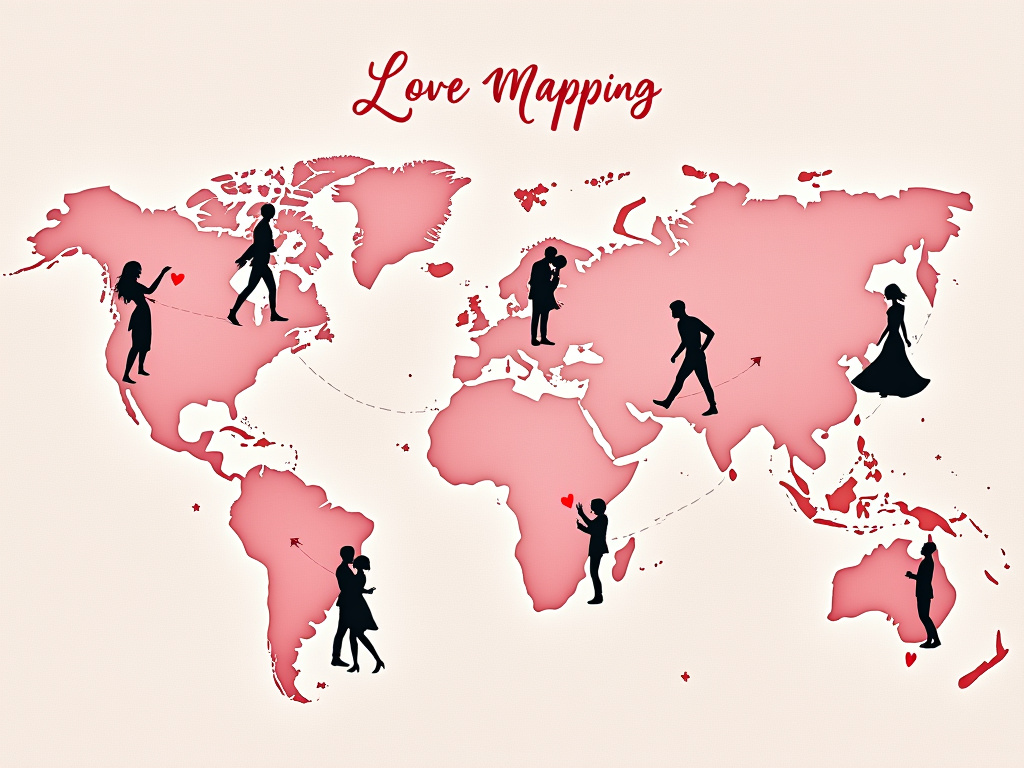
The Sound Relationship House: How to Build Love Maps for Deeper Understanding
Reading time: 8 minutes
Ever wonder why some couples seem to effortlessly navigate life’s challenges while others struggle with basic communication? The secret often lies in something relationship experts call “Love Maps” – and they’re far more powerful than you might imagine!
Table of Contents
- Understanding Love Maps: Your Relationship GPS
- The Sound Relationship House Framework
- Building Effective Love Maps: Practical Strategies
- Navigating Love Maps in the Digital Age
- Overcoming Common Love Map Obstacles
- Your Relationship Blueprint for Success
- Frequently Asked Questions
Understanding Love Maps: Your Relationship GPS ️
Think of Love Maps as your internal GPS for understanding your partner’s inner world. Dr. John Gottman, renowned relationship researcher, discovered that couples with detailed Love Maps – those who truly know each other’s dreams, fears, and daily experiences – are 67% more likely to navigate relationship storms successfully.
But here’s what most people miss: Love Maps aren’t just about knowing your partner’s favorite coffee order or their childhood pet’s name. They’re about understanding the why behind their emotions, the stories that shaped their worldview, and the dreams that fuel their daily motivation.
The Science Behind Emotional Intimacy
Research from the Gottman Institute reveals that couples who regularly update their Love Maps show significantly higher relationship satisfaction scores:
Love Map Effectiveness Comparison
The Sound Relationship House Framework
Gottman’s Sound Relationship House model places Love Maps as the foundational level – and for good reason. Without this foundation, everything else becomes unstable. Think of it like building a house: you wouldn’t start with the roof, would you?
The Seven Levels Explained
While Love Maps form the foundation, understanding how they integrate with other levels amplifies their power:
| Level | Component | Love Map Integration | Success Rate |
|---|---|---|---|
| 1 | Love Maps | Foundation for all other levels | Essential |
| 2 | Nurture Fondness | Recall positive memories stored in maps | 85% |
| 3 | Turn Towards | Recognize bid patterns through understanding | 78% |
| 4 | Positive Perspective | Frame conflicts using partner knowledge | 82% |
| 5 | Manage Conflict | Address core needs revealed in maps | 76% |
Case Study: Sarah and Mike’s Digital Transformation
Consider Sarah and Mike, a couple struggling with connection after transitioning to remote work. Initially, they felt like strangers sharing a space. By implementing a structured Love Map approach, they discovered:
- Sarah’s hidden stress: She felt disconnected from her creative identity while working from home
- Mike’s unspoken need: He craved structured conversations but didn’t know how to initiate them
- Shared discovery: Both missed the “commute conversation” ritual that naturally updated their daily Love Maps
Their solution? A daily 15-minute “emotional check-in” that replaced their lost commute time, resulting in improved intimacy within six weeks.
Building Effective Love Maps: Practical Strategies
Creating meaningful Love Maps isn’t about conducting interrogations or keeping spreadsheets of preferences. It’s about cultivating curiosity about your partner’s evolving inner world.
The Three-Tier Approach
Tier 1: Surface Knowledge – Basic preferences, daily routines, obvious stressors
Tier 2: Emotional Landscape – Triggers, comfort patterns, celebration styles
Tier 3: Core Identity – Life dreams, fundamental values, childhood influences
Practical Implementation Strategies:
Daily Micro-Updates: Instead of generic “How was your day?” try specific questions like “What surprised you today?” or “What made you feel most accomplished?”
Weekly Deep Dives: Dedicate 30 minutes weekly to exploring one aspect of your partner’s inner world. This week: childhood memories that still influence their decisions. Next week: current worries they haven’t shared.
Monthly Map Reviews: How have your partner’s priorities shifted? What new stressors have emerged? What dreams are becoming more or less important?
The Love Map Question Framework
Rather than random questioning, use this progressive structure:
- Observation Questions: “I noticed you seemed energized after that call – what made it special?”
- Exploration Questions: “Help me understand why that type of recognition matters to you”
- Connection Questions: “How can I better support you when those situations arise?”
Navigating Love Maps in the Digital Age
Modern relationships face unique Love Map challenges. We’re simultaneously more connected and more distracted than ever before. The average couple spends 4.5 hours daily on devices but only 37 minutes in meaningful conversation.
Digital Love Map Strategies
Mindful Technology Integration: Use apps and digital tools to enhance rather than replace emotional connection. Share articles that resonate with your values, send voice messages that convey tone, use location sharing to understand your partner’s daily rhythm.
Digital Detox Periods: Establish device-free zones for Love Map building. The bedroom, dinner table, and first 30 minutes after reuniting should be sacred spaces for emotional connection.
Asynchronous Love Mapping: Long-distance or busy couples can build Love Maps through voice notes, shared digital journals, or scheduled video calls with specific emotional check-in agendas.
Case Study: Emma and David’s Long-Distance Success
Emma (London) and David (New York) maintained strong Love Maps across time zones by creating a shared digital space where they documented daily observations about each other. Their “Love Map Journal” included:
- Daily emotional weather reports
- Weekly goal and challenge updates
- Monthly dream and aspiration reviews
- Quarterly relationship visioning sessions
Result: Their relationship satisfaction scores actually increased during their 18-month long-distance period.
Overcoming Common Love Map Obstacles
Challenge 1: The Assumption Trap
Many couples believe they already know everything about their partner. Research shows that even couples married 20+ years correctly predict their partner’s responses only 35% of the time on emotional questions.
Solution: Adopt a “beginner’s mind.” Approach your partner with genuine curiosity, as if meeting them for the first time. What assumptions might you be making?
Challenge 2: Surface-Level Sharing
Busy lives often reduce couples to logistical communications: schedules, tasks, problem-solving. Emotional intimacy requires vulnerability.
Solution: Implement the “Emotional First” rule. Before discussing logistics, share one genuine emotional experience from your day.
Challenge 3: Judgment and Defensiveness
When partners share vulnerable information, the response determines whether Love Maps deepen or shut down.
Solution: Practice the “Acceptance Response”: “Thank you for sharing that with me. Help me understand what support looks like in this situation.”
Your Relationship Blueprint for Success
Building robust Love Maps isn’t a destination—it’s an ongoing journey of discovery that evolves with your relationship. As modern relationships increasingly navigate digital communication, remote work dynamics, and changing social structures, the couples who thrive are those who intentionally invest in understanding each other’s inner worlds.
Your 30-Day Love Map Action Plan:
Week 1: Foundation Building
• Implement daily 15-minute device-free emotional check-ins
• Ask one deeper question each day using the progressive framework
• Create a shared space for documenting discoveries about each other
Week 2: Pattern Recognition
• Identify your partner’s energy patterns throughout the day
• Notice emotional triggers and comfort responses
• Map their preferred communication styles for different situations
Week 3: Core Exploration
• Discuss childhood experiences that still influence current behavior
• Explore evolving dreams and aspirations
• Understand each other’s fundamental values and how they’re expressed daily
Week 4: Integration and Refinement
• Practice using Love Map knowledge to enhance daily interactions
• Experiment with personalized support strategies
• Plan quarterly Love Map review sessions for ongoing maintenance
The future of relationships belongs to those who master the art of genuine knowing. In a world of surface-level connections, deep Love Maps become your competitive advantage for lasting intimacy.
Ready to transform your relationship from the foundation up? What’s one thing about your partner’s inner world that you’re curious to explore this week?
Frequently Asked Questions
How long does it take to build comprehensive Love Maps?
While basic Love Maps can develop within 2-3 months of consistent practice, comprehensive understanding is an ongoing process. Most couples notice significant improvements in emotional connection within 6-8 weeks of dedicated Love Map building. Remember, people continuously evolve, so Love Maps require regular updates rather than one-time completion.
What if my partner isn’t interested in building Love Maps?
Start by modeling curiosity and emotional sharing yourself. Many resistant partners become more open when they experience the benefits firsthand. Focus on asking genuine questions about their experiences rather than explaining the “Love Map” concept. If resistance continues, consider couples counseling to address underlying communication barriers.
Can Love Maps work for new relationships or are they only for long-term couples?
Love Maps are actually most powerful in new relationships! Early relationship stages are ideal for establishing patterns of curiosity and emotional intimacy. Starting Love Map practices within the first few months creates a strong foundation for long-term success. The key is maintaining appropriate boundaries while gradually deepening understanding as trust develops.

Article reviewed by Nikola Horvat, Marriage Counselor | Restoring Trust & Communication in Relationships, on May 29, 2025


